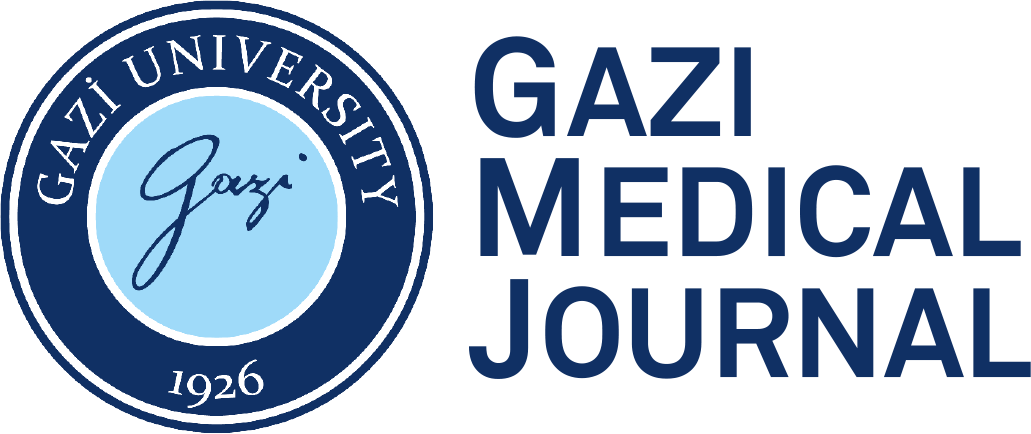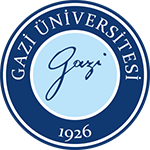ABSTRACT
Objective
This study aimed to investigate the prognostic significance of the C-reactive protein-albumin-lymphocyte (CALLY) index in patients with early-stage gastric cancer and compare it with other immune markers, such as systemic immune-inflammation index (SII), neutrophil lymphocyte ratio (NLR), and prognostic nutritional index (PNI).
Methods
We retrospectively analyzed patients with early-stage gastric cancer who received adjuvant or perioperative chemotherapy. Laboratory results were obtained from the preoperative period. The CALLY index was calculated as follows: serum albumin level (g/dL) x absolute lymphocyte counts (109/L) / CRP (mg/dL) x104.
Results
A total of 74 patients were included in the study. The median relapse-free survival (RFS) was 13.0 (95 %CI: 7.7-18.2) months in the low CALLY index group and 38.2 (95% CI:18.4-57.8) months in the high CALLY index group (p<0.001). The median overall survival (OS) was 25.0 (95% CI: 17.1-32.8) months in the low CALLY index group and 60.4 (95% CI:45.8-74.1) months in the high-CALLY-index group (p<0.001). In multivariate cox regression analyses, a low CALLY index was an independent risk factor for both relapse-free survival (RFS) and OS.
Conclusion
The CALLY index was a prognostic factor for both RFS and OS, with a higher prognostic value than other prognostic factors (NLR, PNI, SII).
INTRODUCTION
Adjuvant/perioperative chemotherapy is the standard treatment for early-stage/locally advanced gastric cancer after gastrectomy (1-3). Despite the use of adjuvant/perioperative chemotherapy, recurrence rates are substantial and vary according to the pathological tumor node metastasis (TNM) stage (4, 5). It is critical to identify patients with a high relapse rate because this can affect follow-up and treatment strategies. Recently, researchers have explored biomarkers to predict the recurrence rate in addition to the pathological TNM stage in several solid tumors (6-9). Several markers have also been assessed in patients with early-stage/locally advanced gastric cancer (10-12). The neutrophil lymphocyte ratio (NLR) and systemic immune inflammation index (SII) are the most frequently investigated biomarkers (13, 14). Recently, albumin and C-reactive protein (CRP) have started to be incorporated into these indicators because of their roles in cancer inflammation (15-17). The prognostic nutritional index (PNI), which was calculated using albumin and lymphocytes, was significant in gastric cancer because patients experienced weight loss and malnutrition after gastrectomy (18, 19). The CRP albumin lymphocyte (CALLY) index is a recently validated biomarker for hepatocellular carcinoma (HCC) patients (20). The prognostic value of this treatment was assessed in the oral cavity, esophagus, non-small cell lung cancer, and colorectal cancer (21-24). However, the CALLY index has not yet been evaluated for early-stage gastric cancer. We aimed to assess the prognostic value of the CALLY index in patients with early-stage gastric cancer and compare it with conventional immune markers, such as the SII, NLR, and PNI.
MATERIALS AND METHODS
The study protocol was approved by the ethics committee of Gazi University Faculty of Medicine (approval number: 05, date: 12.03.2024). Patients did not provide written informed consent due to the retrospective study design. Every procedure was performed in accordance with the ethical guidelines and principles established by the Declaration of Helsinki.
Patients and Data Collection
We retrospectively included 74 patients diagnosed with an early-stage gastric cancer between May 2014 and August 2020. Medical records revealed clinical and pathological information including age, sex, preoperative CRP, albumin, and lymphocyte values, preoperative body weight, tumor invasion depth, lymph node metastasis, lymphovascular invasion (LVI), perineural invasion (PNI), differentiation type, and recurrence time. The American Joint Committee on cancer TNM staging system was used. Preoperative weight and height data of the patients were collected, and body mass index was calculated by dividing the weight (in kilograms) by the square of the height (in meters). CALLY index was calculated as follows: Serum albumin level (g/dL) x absolute lymphocyte counts (109/L)/CRP (mg/dL) x104. The SII was calculated using the following formula: [neutrophil (cellsx109/L) x platelet (cells x109/L)]/lymphocyte (cells x109/L). PNI was formulated as: albumin (g/L) +5x L (109/L). NLR=N/L, SII=PxN/L (N: neutrophil, P: platelet, L: lymphocyte).
Statistical Analysis
Continuous variables are reported as means and standard deviations. Using Student’s t-test, the means were compared. The Chi-square test or Fisher's exact test was used to compare groups whose categorical variables were calculated as numbers and percentages. Optimal cut-off values were determined using the receiver operating characteristic curve and were found to be 1.34 for the CALLY index. The optimal cutoff values were 2.4 for NLR, 48.5 for PNI, and 681x109/I for SII. Patients were divided into low and high according to cut-off values. Overall survival (OS) was defined as the interval between operation and death. The definition of recurrence-free survival (RFS) was the duration between gastric cancer surgery and recurrence. Using the Kaplan-Meier method was used to calculate survival curves. The log-rank test was used to determine the differences between the curves. Hazard ratios (HRs) were determined using Cox regression analyses. In the multivariate Cox regression analysis, all variables with a p value <0.05 in the univariate analysis were included. P value<0.05 was considered statistically significant, and a 95% confidence interval (CI) was determined. SPSS software (version 27.0; SPSS, Chicago, IL, USA) was used for all statistical analyses.
RESULTS
Patient Characteristics
A total of 74 patients were included in the study. The median age was 60 (28-74) years. 28 (37.8%) patients were women. 18 (24.3%) had a signet ring cell component. Poor differentiation was observed in 11 (14.9%) of the samples. The baseline characteristics of the patients according to the CALLY index are demonstrated in Table 1. Her-2 and PD-L1 status was not known, since the study was retrospective and was not performed in the early stage due to the payment conditions of our country.
Recurrence-free Survival Analysis
At the end of the follow-up period, 35 (47.3%) patients had relapsed, and 18 (51.4%) of them were in the low CALLY index group. The median RFS was 13.0 (95% CI: 7.7-18.2) months in the low CALLY index group and 38.2 (95% CI:18.4-57.8) months in the high CALLY index group (p<0.001). According to univariate analyses, besides stage 2 disease, a high CALLY index (HR: 0.46; 95% CI: 0.29-0.73, p<0.001) and high PNI (HR: 0.55; 95CI: 0.35-0.86, p=0.01) was associated with a longer RFS. In the multivariate Cox regression analyses, only stage 3 disease (HR: 2.12; 95% CI: 1.26-3.55, p=0.004) and low CALLY index (HR: 2.16; 95% CI: 1.36-3.4, p<0.001) were independent risk factors for poor RFS. The Kaplan-Meier curve for RFS according to the CALLY index and Cox regression analyses is demonstrated in Figure 1 and Table 2.
Overall Survival Analysis
The median follow-up period was 33.5 months. The median OS was 25.0 (95% CI: 17.1-32.8) months in the low CALLY index group and 60.4 (95% CI: 45.8-74.1) months in the high CALLY index group (p<0.001). According to univariate analysis, other than stage 2 disease, a high CALLY index (HR: 0.45, 95% CI: 0.28-0.71, p<0.001) and a high PNI (HR: 0.53; 95% CI: 0.33-0.85, p=0.009) related to longer OS. In the multivariate Cox regression analyses, only stage 3 disease (HR: 2.49; 95% CI: 1.47-4.21, p<0.001) and low CALLY index (HR: 2.22; 95% CI: 1.39-3.54, p<0.001) were independent risk factors for poor OS. The Kaplan-Meier curve for OS according to the CALLY index and Cox-regression analyses is presented in Figure 2 and Table 3.
DISCUSSION
This study demonstrated that in patients with early-stage gastric cancer treated with adjuvant/perioperative chemotherapy, the CALLY index was a prognostic factor for both RFS and OS, with a higher prognostic value than other prognostic factors (NLR, PNI, SII). The CALLY index is calculated using serum albumin, lymphocyte, and CRP levels and serves as an index reflecting nutrition, immune status, and inflammatory response. Albumin, which is synthesized in the liver with a long half-life, often indicates nutritional status (25). Additionally, albumin can be used as an indicator of inflammatory response, with hypoalbuminemia having strong predictive value for poor prognosis in many cancers (26). Lymphocytes are essential cells in the host’s cytotoxic immune response and have an important influence on the cell-mediated antitumor environment. Lymphopenia within the tumor suggests an insufficient host immune response against the tumor and an unfavorable prognosis (27). CRP, an acute-phase reactant protein regulated by interleukin 6, is a clinically recognized marker of inflammatory response (28). The CALLY index, which combines these three parameters, can serve as a comprehensive marker for cancer diagnosis. Furthermore, its calculation method is not complex and is easily accessible and inexpensive because it is based on laboratory parameters commonly used in practice. When the CALLY index was initially used in HCC, it was found to be much stronger than other indices and closely linked to cancer prognosis (20). Subsequently, the prognostic benefit of the CALLY index has been confirmed in several malignancies. A study involving 279 surgically treated patients with oral cavity cancer revealed that the preoperative CALLY index was a simple and inexpensive prognostic score (21). Another study involving 1260 patients with colorectal cancer reported that the CALLY index was independently associated with prognosis and had a higher clinical value (24). Moreover, a high CALLY-index with an optimal cutoff value of 3.0 was associated with better survival outcomes in patients with epithelial ovarian cancer patients (29). Although CALLY is significantly associated with prognosis in various cancers, the threshold value for CALLY varies. The best CALLY threshold in our study for non-linear relationships between CALLY and prognosis was calculated using the receiver operating characteristic curve. Consequently, CALLY was selected as the best potential indicator for the classification of nutrition and immune-inflammatory prognosis compared with other immune-inflammatory indices. Although previous studies have demonstrated the prognostic significance of the CALLY index in several cancers, no study has investigated its prognostic value of the CALLY index in early stage gastric cancer to date.
CONCLUSION
This study is the first to explore the prognostic value of the CALLY index in early-stage gastric cancer. The findings demonstrate that the CALLY index is a significant prognostic factor for both recurrence-free survival and overall survival. However, there are some limitations. First, this was a retrospective study and may have incurred selection bias. Second, the sample size was small, as patients with stage I disease and those treated with regimens other than FOLFOX and FLOT were excluded to create a more homogeneous group. Lastly, the optimal cutoff value for the CALLY index has not been uniformly reported across studies. Therefore, prospective studies with clearly defined cutoff values and larger cohorts are needed to validate its prognostic potential.



